|
Chilopoda
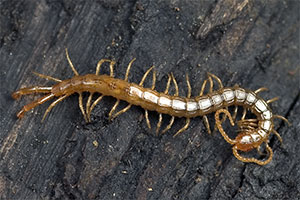 Cryptops
Cryptops sp., a common New Zealand centipede. Common name: centipedes, Maori weri.
Scientific name: phylum Arthropoda, class Chilopoda. From Greek “cheilos”, lip, and “poda”, legs (referring to the jaw-like appendages).
Description
Chilopoda, or centipedes, can be recognized easily by their elongate, flattened multi-segmented body, many legs, and wriggling running gait. The centipedes are commonly 2-5 cm in size, although some tropical forms reach over 20 cm.
Each segment of the body bears a single pair of walking legs; the total number of segments and pairs of legs can vary from fifteen to more than a 100. The segments of the body are covered with lightly sclerotized, leathery plates, connected to one another by the soft pliable cuticle. The last legs differ in structure and function; often they are modified as genital appendages (gonopodes).
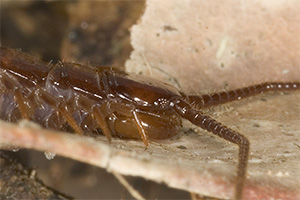
Head of Lithobius sp. The head is flattened dorso-ventrally and
bears a pair of long antennae. Centipedes have either a large
single ocellus, or more often a group of ocelli on each side
of the head. Only few centipedes posess compound eyes. Many
centipedes lack eyes entirely.
The remarkable and unique feature of centipedes
are the large, robust, pincer-like appendages of the first
segment following the head – the forcipules, also known
as maxillipedes, or poison-claws. The forcipules are modified
legs, which function as jaws; they are jointed, open and close
in horizontal plane, and end in sharp claws. The centipedes
use forcipules to capture and poison their prey. The ducts
of poison glands open near the tips of the claws. The forcipules
are found in all Chilopoda and occur in no other arthropods.
The centipedes are classified into five
orders – Geophilomorpha, Scolopendromorpha, Lithobiomorpha, Scutigeromorpha and Craterostigmomorpha.
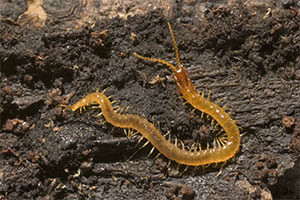 Zelanion
Zelanion sp., a geophilomorph centipede.
Order Geophilomorpha
Geophilomorphs are adapted for underground existence – these are slow moving, long, thin, entirely eyeless centipedes with very numerous short legs. The body length varies from less than 1 cm to over 25 cm, with 31 to 181 (always odd number) pairs of legs. Colour in different species ranges from reddish-brown to very pale yellow. Geophilomorpha are morphologically and biologically the most diverse centipedes, and are related to the Scolopendromorpha.
Order Scolopendromorpha
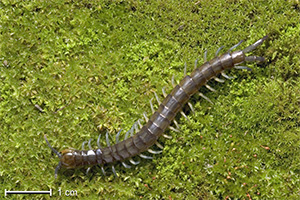 Cormocephalus
Cormocephalus sp. from Taranaki region. The Scolopendromorpha include the world’s largest centipedes, with some tropical forms reaching over 25 cm in length. Native to New Zealand, the giant scolopendromorph centipede Cormocephalus rubriceps can reach over 16 cm in length, although most other New Zealand Scolopendromorpha, especially soil dwellers, are much smaller and do not exceed 5 cm. Scolopendromorpha always have twenty-one pair of legs. Many are blind, but some have simple eyes (ocelli).
Order Scutigeromorpha
Due to their striking spider-like appearance, Scutigeromorpha are unlikely to be confused with other centipedes. Scutigeromorpha are active sight hunters, with large compound eyes, relatively short body, long, whip-like antennae, and very long legs, making them amazingly fast and agile. The dorsal plates (tergites) are fused to form seven larger plates; there are 15 ventral plates and 15 pairs of legs. The House Centipede Scutigera is greyish-yellow with dark stripes along the 2.5-3 cm body and can be seen in and around houses in Auckland City and sometimes gets trapped in sinks and bathtubs.
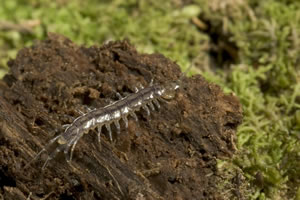 Henicops maculatus
Henicops maculatus, a native New Zealand Lithobiomorpha.
Order Lithobiomorpha
The Lithobiomorpha are shorter and more compact centipedes and are very active. Adult Lithobiomorpha range in size from 0.5 cm to over 3 cm, and have 15 pairs of legs. Most possess ocelli, either one or a group of several, although there are some blind species. The most familiar, active brown or reddish centipedes common around human habitations in New Zealand are Lithobiomorpha.
Occasionally one finds beautiful violet individuals – these are freshly moulted Lithobius centipedes, which become reddish-purple when hardened.
Order Craterostigmomorpha
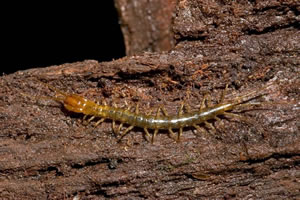 Craterostigmus crabilli
Craterostigmus crabilli from New Zealand.
The centipede Craterostigmus is a unique animal with a very restricted distribution, and has been placed in a separate order Craterostigmomorpha. Craterostigmus tasmanianus from Tasmania and the recently described Craterostigmus crabilli from New Zealand are the only species in the order. The New Zealand Craterostigmus is a medium-sized (up to 5 cm), greenish-brown centipede, with a large, elongate, red-brown head. The forcipules are massive and clearly visible from above, framing the head. The adult Craterostigmus have 15 pairs of legs but 21 tergites, as some tergites are subdivided. There is one pair of ocelli. Little is known about the biology of this centipede in New Zealand, although it is not uncommon.
Notes on biology
 Lithobius
Lithobius sp., a common garden centerpede. All centipedes
are predators, able to tackle relatively large and active prey, grasping and
paralysing their victims with their poison-claws. Centipedes attack a large
variety of invertebrate prey – other soil arthropods, earthworms,
molluscs, etc. Large tropical Scolopendromorpha even prey on vertebrates
– frogs and birds. In turn, many centipedes are preyed upon by birds and
mammals. In New Zealand, introduced rats have reduced the numbers of the giant
centipede Cormocephalus rubriceps. Predatory ground beetles and large
spiders may also hunt centipedes, particularly the juveniles.
Centipedes have separate sexes, although
males are absent in some parthenogenetic species. The male
produces spermatophores and deposit them into a specially
constructed web, from where they are picked up by the female.
Fertilization is internal. Two types of brooding behaviour
and development exist in centipedes. In Geophilomorpha and
Scolopendromorpha, the female lays an egg mass in a cavity
excavated in the soil. The female remains in the cavity coiled
around the eggs until they have hatched. The newborn centipedes
resemble miniature adults and have the adult number of legs,
although the reproductive parts are not developed. Growth
and development is through a series of moults. In Lithobiomorpha
and Scutigeromorpha, the female lays the eggs one by one,
and abandons them. The newborn centipedes have incomplete
numbers of segments and legs; more segments and legs are progressively
added with each moult until they reach the adult number. The
stadia with incomplete number of legs are known as larvae.
There are four larval stages, and four more post-larval moults
until maturity is reached.
Each stage of development lasts for several
months, and in cold climates a centipede can take 2-3 years
to reach maturity. Adult centipedes continue to moult, further
increasing in size. Many die after their first breeding season,
but many continue to live and moult for several more years.
Centipedes are
able to regenerate lost appendages – the regenerating appendage slowly
develops with each consequent moult, although a perfect appendage is
regenerated only if the injury had occurred at an early stage in development;
otherwise the regenerated appendage is deformed and stunted.
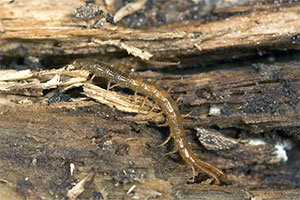 Cryptops
Cryptops in a rotting log.
Where to find them?
As with many other soil animals, centipedes lose water through the cuticle and dehydrate easily, which restricts them to relatively humid surroundings. All centipedes avoid daylight. Centipedes are found under stones, beneath loose tree bark, between the layers of decaying leaves on the forest floor, in soil and rotting logs, and in other similar situations. Around human habitations, centipedes are often encountered in compost heaps, under outdoor rubbish, among garden debris, under tiles, etc. Most species show preference for a particular habitat – there are species that exploit logs, various soil and humus layers, even piles of seaweed at the beaches.
Different adaptations and habits are found
in different groups of centipedes. The blind Geophilomorpha,
with their long, narrow, flexible bodies and numerous short
legs are burrowers and exploiters of small crevices. Geophilomorphs
are common under the bark of fallen trees, in decayed timber,
and in soil. The Lithobiomorpha, with their relative lack
of flexibility, compact form, speedy movement and ocelli,
occupy more superficial microhabitats. Scolopendromopha are
intermediate in their microhabitat preferences.
Miniature
centipedes – small Lithobiomorpha, Geophilomorpha, larval stages –
are a common part of Berlese extractions. Larger centipedes are not collected
by Berlese funnels, nor are they well represented in pitfall traps. Large
centipedes can be collected directly, with fingers or forceps, although large,
active Lithobiomorpha and Scolopendromorpha often move very rapidly and are not
easy to grasp or photograph. Most centipedes are harmless, but the larger
specimens can protect themselves and may pinch the skin, which can be quite
unpleasant. Large Scolopendromorpha are capable of inflicting a very painful
bite and may be dangerous to sensitive individuals or small children. A useful
capture method is to grab a handful of substrate containing the centipede, and
place it in a plastic bag or a container, which can be examined in the lab. If
centipedes are kept live, each one should be kept in its own separate
container, as they may damage and even eat each other. Centipedes can be
preserved in 70% alcohol.
Distribution and conservation
Worldwide, there
are currently around 3,000 described species of centipedes. There are still
many undescribed species, and the distribution of described species is not well
understood. Scolopendromorpha (~ 600 species) and Scutigeromorpha (80 species)
are distributed mainly in the tropics, although scolopendromorphs are common in
New Zealand. Geophilomorpha (>1,100 species) are found nearly worldwide.
Lithobiomorpha (~ 1,500 species) are well represented in temperate regions of
both the northern and southern hemispheres, but rare and poorly represented in
the tropical regions. The relict Craterostigmomorpha are restricted to Tasmania and New
Zealand. Centipede fauna of New Zealand is distinctly
southern (Gondwanan) in type and includes at least 35 species; several genera
are endemic.
New Zealand
centipedes are abundant in all habitats from sea level to high elevations. They
are most common in woodlands, but are also found in open country and around
farms and houses. The unique Craterostigmus occurs in forest habitats
of the South Island, where it is quite common. Similar to other soil animals, centipedes
are subjects to human dispersion with soil and plant materials.
The introduced Lithobius peregrinus (Lithobiomorpha)
is a common centipede in New Zealand gardens. The European
House Centipede Scutigera coleoptrata (Scutigeromorpha)
has been introduced and has established in New Zealand. At
the same time, native centipedes are threatened by habitat
destruction. Introduced mammals, such as rats and mice, present
a significant threat to larger species. New Zealand’s
largest native centipede, the giant Cormocephalus rubriceps
is up to 20 cm in length and occurs throughout the North Island
and nearby islands, particularly in the north. Due to rat
predation, full-sized individuals are now found only on rat-free
islands, as the mainland centipedes fall victim to predators
before they reach the maximum size.
Included images:
- Order Scolopendromorpha
- Family Scolopendridae
- Cormocephhalus rubiceps - Ohinetonga, TO, North Island
- Family Cryptopidae
- Cryptos sp. - Nelson, NN, South Island
- Cryptos sp. - Craigieburn Forest Park, Cave Stream, NC, South Island (3 images)
- Other
- Unidentified species - Takapari Road, southern Ruahine Ranges, RI/WN, North Island
- Order Craterostigmomorpha
- Family Craterostigmidae
- Craterostigmus crabilli Edgecombe & Giribet, 2008 - Kahurangi National Park, Flora Saddle, NN, South Island (2 images)
- Order Geophilomorpha
- Family Chilenophilidae
- Zelanion sp. - Rimu Valley Walk, NN, South Island (2 images)
- Other
- Unidentified species - Canaan Road, NN, South Island
- Order Lithobiomorpha
- Family Henicopidae
- Henicops maculatus (Newport, 1845) - Rimu Valley Walk, SD, South Island (2 images)
- Family Lithobiidae
- Lithobius forficulatus* - Palmerston North, WI, North Island (2 images)
- Lithobius sp.* - Nelson, NN, South Island
- Other
- Unidentified species - Trounson Kauri Park, Northland, ND, North Island
- * - species exotic in NZ
Further information on New Zealand
Chilopoda:
Archey, G. 1936. Revision of the Chilopoda
of New Zealand part 1. Records of Auckland Institute and Museum 2(1), p. 43-70.
Archey, G. 1937. Revision of the Chilopoda
of New Zealand part 2. Records of Auckland Institute and Museum 2(2), p.
71-100.
Bennet, B.G. 1981. Notes on the giant New Zealand centipede, Cormocephalus
rubriceps. Weta 4, p. 6.
Edgecombe, G.D. 2004. The henicopid
centipede Haasiella (Chilopoda: Lithobiomorpha): new species from
Australia, with a morphology-based phylogeny of Henicopidae. Journal of Natural
History 38, p. 37-76.
Edgecombe, G.D. 2004. A new species of Paralamyctes
(Chilopoda: Lithobiomorpha) from New Zealand. Zootaxa 451, p. 1-16.
Lewis, J.G.E. 1981. The Biology of
Centipedes. Cambridge: Cambridge University Press. 476 pp.
Mesibov, R. 1995. Distribution and ecology
of the centipede Craterostigmus tasmanianus Pocock, 1902 (Chilopoda:
Craterostigmomorpha: Craterostigmidae) in Tasmania. The Tasmanian Naturalist
117, p. 2-7.
Chilopoda Resources on the Web
Centipede - Wikipedia.
CSIRO Insects and their Allies, Chilopoda - centipedes.
ID tools - Chilopoda
Gordon's
centipedes page
Kentucky
Centipedes
Tree of Life Web Project - Chilopoda
|